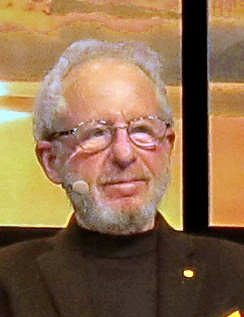Alan J. Heeger facts for kids
Quick facts for kids
Alan J. Heeger
|
|
|---|---|

Heeger in 2013
|
|
| Born |
Alan Jay Heeger
January 22, 1936 Sioux City, Iowa, United States
|
| Alma mater | University of Nebraska University of California, Berkeley |
| Known for | SSH model |
| Spouse(s) | Ruth (2 children) |
| Awards | Nobel Prize in Chemistry (2000) Balzan Prize ENI award Oliver E. Buckley Condensed Matter Prize (1983) |
| Scientific career | |
| Fields | Physics, Chemistry |
| Institutions | University of Pennsylvania University of California, Santa Barbara |
| Thesis | Studies on the magnetic properties of canted antiferromagnets (1962) |
| Doctoral advisor | Alan Portis |
| Doctoral students | Fan Chunhai (postdoc student) |
Alan Jay Heeger (born January 22, 1936) is an American physicist and professor. He is famous for winning the Nobel Prize in Chemistry in 2000. He helped discover and develop special materials called conductive polymers. These are like plastics that can carry electricity, which was a big surprise to scientists!
Contents
Early Life and Education
Alan Heeger was born in Sioux City, Iowa. He grew up in a small town called Akron, Iowa. When he was nine years old, his family moved back to Sioux City.
Heeger loved learning about science. He earned his first degree in physics and mathematics from the University of Nebraska in 1957. Later, he received his Ph.D. (a higher degree) in physics from the University of California, Berkeley in 1961.
A Career in Science
After finishing his studies, Heeger became a professor. From 1962 to 1982, he taught at the University of Pennsylvania. In 1982, he moved to the University of California, Santa Barbara. There, he became a professor in both the Physics Department and the Materials Department.
His amazing research has even led to new companies being started. These companies use his discoveries to create new technologies. Some of these companies include Uniax, Konarka, and Sirigen.
Discovering Conductive Polymers
Alan Heeger won the Nobel Prize in Chemistry in 2000. He shared this huge honor with two other scientists, Alan G. MacDiarmid and Hideki Shirakawa. They won for their groundbreaking work on "conductive polymers".
What are conductive polymers? Imagine plastic that can conduct electricity, just like metal wires! Before their discovery, plastics were thought to be insulators, meaning they blocked electricity. In 1977, these scientists published their findings about a conductive polymer called polyacetylene. This discovery opened up a whole new field of science and led to many new inventions.
Their work also helped create the Su–Schrieffer–Heeger model. This is a simple but important model that helps scientists understand how these special materials work.
Awards and Family
Before winning the Nobel Prize, Alan Heeger received other important awards. In 1983, he won the Oliver E. Buckley Condensed Matter Prize from the American Physical Society. In 1995, he was awarded the Balzan Prize for his work on non-biological materials.
Alan Heeger has two sons who are also scientists. His son David Heeger is a neuroscientist, who studies the brain. His other son, Peter Heeger, is an immunologist, who studies the body's immune system.
Inspiring Young Scientists
Alan Heeger loves to share his passion for science. In October 2010, he took part in a special program called "Lunch with a Laureate." During this program, middle and high school students got to have an informal chat with a Nobel Prize winner. Heeger is also part of the advisory board for the USA Science and Engineering Festival. This festival helps get young people excited about science.
He once said, "Perhaps the greatest pleasure of being a scientist is to have an abstract idea, then to do an experiment... that demonstrates the idea was correct." He believes that seeing your ideas work in real life is the most exciting part of science.
See also
 In Spanish: Alan J. Heeger para niños
In Spanish: Alan J. Heeger para niños
- List of Nobel laureates affiliated with the University of California, Santa Barbara
- List of Jewish Nobel laureates

